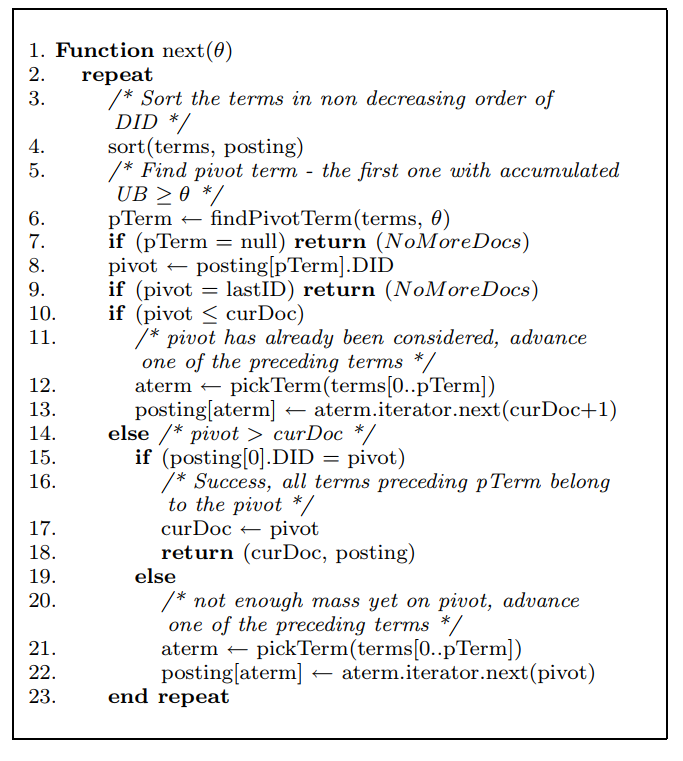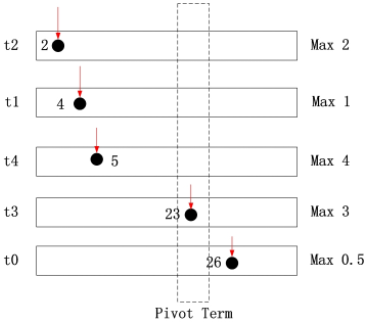Wand 算法介绍与实现
本文主要介绍 Wand (Weak And) 算法的原理和实现,Wand 算法是一个搜索算法,应用在 query 有多个关键词或标签,同时每个 document 也有多个关键词或标签的情形(如搜索引擎);尤其是在 query 中的关键词或标签较多的时候,通过 Wand 能够快速的选择出 Top n 个相关的 document,算法的原始论文见 Efficient Query Evaluation using a Two-Level Retrieval Process,本文主要讲述这个算法的原理以及通过 python 实现这个算法。
一般来说,检索往往会利用倒排索引,倒排索引能够根据 query 中的关键词快速检索到候选文档,然而当候选文档集合较大时,遍历整个候选文档所需要的时间也很大。
但是检索需要得到的往往只是 Top n 个结果,在遍历候选文档过程中能否跳过一些与 query 相关性较低的文档,从而加速检索的过程呢?Wand 算法就是干这个事的。
Wand 原理介绍
Wand 算法通过计算每个词的贡献上限来估计文档的相关性上限,并与预设的阈值比较,进而跳过一些相关性一定达不到要求的文档,从而得到提速的效果。
上面这句话涵盖了 Wand 算法的思想,下面进行详细说明:
Wand 算法首先要估计每个词对相关性贡献的上限(upper bound),最简单的相关性就是 TF-IDF,一般 IDF 是固定的,因此只需要估计一个词在各个文档中的词频 TF 上限 (即这个词在各个文档中最大的 TF),该步骤通过线下计算即可完成。
线下计算出各个词的相关性上限,可以计算出一个 query 和一个文档的相关性上限值,就是他们共同出现的词的相关性上限值的和,通过与预设的阈值比较,如果 query 与文档的相关性大于阈值,则进行下一步的计算,否则丢弃。
在上面过程中,如果还是将 query 和一个一个文档分别计算相关性,并没有减少时间复杂度, Wand 算法通过一种巧妙的方式使用倒排索引,从而能够跳过一些相关性肯定达不到要求的文档。
Wand 算法步骤如下
- 建立倒排索引,记录每个单词所在的所有文档 ID (DID),ID 按照从小到大排序
- 初始化 posting 数组,使得 posting [pTerm] 为词 pTerm 倒排索引中第一个文档的 index
- 初始化 curDoc = 0(文档 ID 从 1 开始)
接着可以执行下面的 next 函数 (摘自原始论文),
上面流程中用到的几个函数的含义如下
1. sort(terms, posting):根据 posting 数组指向的当前文档 ID,对所有的 terms 从小到大排序。如下是三个 term 及其对应的索引文档的 ID,此时的 posting 数组为 [1, 0, 1], 则根据各个 term 当前文档 ID 排序的结果应该是 t1, t2, t3
t0: [3, 26] t1: [4, 10, 100] t2: [2, 5, 56]
2. findPivotTerm(terms, θ):按照之前得到的排序,从第一个 term 开始累加各个 term 的相关性贡献的上限(upper bound,UB),这个在之前已经通过离线计算出来;直到累加和大于等于设定的阈值 θ, 返回当前的 term。这里应用这篇文章的一个例子,下面为通过 sort (terms, posting) 后的倒排索引,假设阈值 θ = 8
对于 doc 2,其可能的最大得分为 2<8
对于 doc 4,其可能的最大得分为 2+1=3<8
对于 doc 5,其可能的最大得分为 2+1+4=7<8
对于 doc 23,其可能的最大得分为 2+1+4+3=10>8 因此,t3 为 pivotTerm,doc 23 为 pivot
3. pickTerm(terms[0..pTerm]):在 0 到 pTerm (不包含 pTerm) 中选择一个 term,关于选择策略,当然是以可以跳过最多的文档为原则,论文中选择了 IDF 最大的 term。以上面的图为例子,此时可以选择 t2, t1 或 t4, 根据其 IDF 值选择最大的 term 即可
4. aterm.iterator.next(n):返回 aterm 这个单词对应的倒排索引中的文档 ID (DID),这个 DID 要满足 DID >= n。则 posting[aterm] ← aterm.iterator.next(n) 其实就是更新了 aterm 在 posting 数组中的当前文档,从而跳过 aterm 对应的索引中一些不必要计算的文档。
还是以上面的图为例子,假如选择的 aterm 为 t2, 则 t2 中指向 2 的指针要往后移动直至 DID >= 23 , 这样便跳过了部分不必计算文档。
实际上,t1, t4 也可以执行上面这个操作,因为在 doc 23 之前的 doc 的得分不可能达到阈值 θ(因为 DID 是经过排序的) ,所以 t2、t1、t4 对应的 posting 数组中的项都可以直接跳到大于等于 doc23 的位置,但是论文中每次只选择一个 term ,虽然多迭代几次也能达到同样效果,但是我认为这里可以三个 Term 可以一起跳。
介绍了上面过程中几个重要函数,下面来看一下上面的几个分支分别表示情况
if (pTerm = null) return (NoMoreDocs)表示当前所有 term 的 upper bound 和达不到阈值 θ ,结束算法if (pivot = lastID) return (NoMoreDocs)表示当前已经没有满足相关性大于阈值 θ 的文档,结束算法if (pivot ≤ curDoc)表示当前 pivot 指向的 DID 已经计算过相关性,需要跳过,这部分代码会在下面第 4 步执行后在进入循环时执行if (posting[0].DID = pivot)表示当前 pivot 对应的文档的相关性有可能满足大于阈值 θ ,返回这篇文档的 ID 并计算这篇文档和 query 的相关性;posting[0].DID = pivot表示从第一个 term 到当前的 term 所指向的文档都是同一篇if (posting[0].DID = pivot) 对应的else语句表示前面遍历过的那些 term 的当前 DID 都不可能满足大于阈值 θ,因此需要跳过,也正是这里大大减少了需要计算相关性的文档数量
Wand 的实现代码
实现 Wand 算法的 Python 代码见这里,参考这篇文章的代码进行了修改,并增加了评估文档和 query 相似性的函数,代码中有以下几点需要注意
- 当一个 term 对应的所有 document 遍历完后,有两种处理方法。第一种方法是直接删除,这样会降低每次排序的时间复杂度和内存占用率,但是每次删除时候是要在一个有序列表内删除,时间复杂度为 \(O(n)\), \(n\) 为 terms 的个数;第二种方法是在每个 term 的 document list 最后增加一个比所有文档 ID 都要大的数 (LastID),这样被遍历完的 term 会自然被排序到最后,整个代码更加简洁。两种方法都尝试了一下,详细代码可见上面的代码连接的提交历史
pickTerm方法原论文采用的是选择 idf 最大值的 term,这里直接选择第一个,因为代码仅用于阐述算法的流程,各个 term 没有 idf 值。当然,如果有各个 term 的 idf 值,是可以根据 idf 选择的- 上面伪代码的算法流程中最后的 else 语句是选择 pivotTerm 中的任意一个并跳过相关性低的文档,但是从前面的解释可知,可以 pivotTerm 前面的所有 term 都可进行这一操作,因此代码里面的这部分跟伪代码不同
这里还是给出完整代码,可以对照着上面的伪代码看,命名方法基本都保持了一致,如有错漏,欢迎指出1
2
3
4
5
6
7
8
9
10
11
12
13
14
15
16
17
18
19
20
21
22
23
24
25
26
27
28
29
30
31
32
33
34
35
36
37
38
39
40
41
42
43
44
45
46
47
48
49
50
51
52
53
54
55
56
57
58
59
60
61
62
63
64
65
66
67
68
69
70
71
72
73
74
75
76
77
78
79
80
81
82
83
84
85
86
87
88
89
90
91
92
93
94
95
96
97
98
99
100
101
102
103
104
105
106
107
108
109
110
111
112
113
114
115
116
117
118
119
120
121
122
123
124
125
126
127
128
129
130
131
132
133
134
135
136
137
138import heapq
UB = {"t0":0.5,"t1":1,"t2":2,"t3":3,"t4":4} #upper bound of term's value
LAST_ID = 999999999999 # a large number, larger than all the doc id in the inverted index
THETA = 2 # theta, threshold for chechking whether to calculate the relevence between query and doc
TOPN = 3 #max result number
class WAND:
def __init__(self, InvertIndex):
"""init inverted index and necessary variable"""
self.result_list = [] #result list
self.inverted_index = InvertIndex #InvertIndex: term -> docid1, docid2, docid3 ...
self.current_doc = 0
self.current_inverted_index = {} #posting
self.query_terms = []
self.sort_terms = []
self.threshold = THETA
self.last_id = LAST_ID
def __init_query(self, query_terms):
"""init variable with query"""
self.current_doc = 0
self.current_inverted_index = {}
self.query_terms = []
self.sort_terms = []
for term in query_terms:
if term in self.inverted_index: # terms may not appear in inverted_index
doc_id = self.inverted_index[term][0]
self.query_terms.append(term)
self.current_inverted_index[term] = [doc_id, 0] #[ docid, index ]
self.sort_terms.append([doc_id, term])
def __pick_term(self, pivot_index):
"""select the term before pivot_index in sorted term list
paper recommends returning the term with max idf, here we just return the firt term,
also return the index of the term instead of the term itself for speeding up"""
return 0
def __find_pivot_term(self):
"""find pivot term"""
score = 0
for i in range(len(self.sort_terms)):
score += UB[self.sort_terms[i][1]]
if score >= self.threshold:
return [self.sort_terms[i][1], i] #[term, index]
return [None, len(self.sort_terms)]
def __iterator_invert_index(self, change_term, docid, pos):
"""find the new_doc_id in the doc list of change_term such that new_doc_id >= docid,
if no new_doc_id satisfy, the self.last_id"""
doc_list = self.inverted_index[change_term]
# new_doc_id, new_pos = self.last_id, len(doc_list)-1 # the case when new_doc_id not exists
for i in range(pos, len(doc_list)):
if doc_list[i] >= docid: # since doc_list contains self.last_id, this inequation will always be satisfied
new_pos = i
new_doc_id = doc_list[i]
break
return [new_doc_id, new_pos]
def __advance_term(self, change_index, doc_id ):
"""change the first doc of term self.sort_terms[change_index] in the current inverted index
return whether the action succeed or not"""
change_term = self.sort_terms[change_index][1]
pos = self.current_inverted_index[change_term][1]
new_doc_id, new_pos = self.__iterator_invert_index(change_term, doc_id, pos)
self.current_inverted_index[change_term] = [new_doc_id, new_pos]
self.sort_terms[change_index][0] = new_doc_id
def __next(self):
while True:
self.sort_terms.sort() #sort terms by doc id
pivot_term, pivot_index = self.__find_pivot_term() #find pivot term > threshold
if pivot_term == None: #no more candidate
return None
pivot_doc_id = self.current_inverted_index[pivot_term][0]
if pivot_doc_id == self.last_id: # no more candidate
return None
if pivot_doc_id <= self.current_doc:
change_index = self.__pick_term(pivot_index)
self.__advance_term(change_index, self.current_doc + 1)
else:
first_doc_id = self.sort_terms[0][0]
if pivot_doc_id == first_doc_id:
self.current_doc = pivot_doc_id
return self.current_doc # return the doc for fully calculating
else:
# pick all preceding term instead of just one, then advance all of them to pivot
change_index = 0
while change_index < pivot_index:
self.__advance_term(change_index, pivot_doc_id)
change_index += 1
# print(self.sort_terms, self.current_doc, pivot_doc_id)
def __insert_heap(self, doc_id, score):
"""store the Top N result"""
if len(self.result_list) < TOPN:
heapq.heappush(self.result_list, (score, doc_id))
else:
heapq.heappushpop(self.result_list, (score, doc_id))
def __calculate_doc_relevence(self, docid):
"""fully calculate relevence between doc and query"""
score = 0
for term in self.query_terms:
if docid in self.inverted_index[term]:
score += UB[term]
return score
def perform_query(self, query_terms):
self.__init_query(query_terms)
while True:
candidate_docid = self.__next()
if candidate_docid == None:
break
#insert candidate_docid to heap
print('candidata doc', candidate_docid)
full_doc_score = self.__calculate_doc_relevence(candidate_docid)
self.__insert_heap(candidate_docid, full_doc_score)
print("result list ", self.result_list)
return self.result_list
if __name__ == "__main__":
testIndex = {}
testIndex["t0"] = [1, 3, 26, LAST_ID]
testIndex["t1"] = [1, 2, 4, 10, 100, LAST_ID]
testIndex["t2"] = [2, 3, 6, 34, 56, LAST_ID]
testIndex["t3"] = [1, 4, 5, 23, 70, 200, LAST_ID]
testIndex["t4"] = [5, 14, 78, LAST_ID]
w = WAND(testIndex)
final_result = w.perform_query(["t0", "t1", "t2", "t3", "t4"])
print("=================final result=======================")
for i in reversed(range(len(final_result))):
print("doc {0}, relevence score {1}".format(final_result[i][1], final_result[i][0]))
参考资料
wand (weak and) 算法基本思路 WAND 算法核心部分梳理